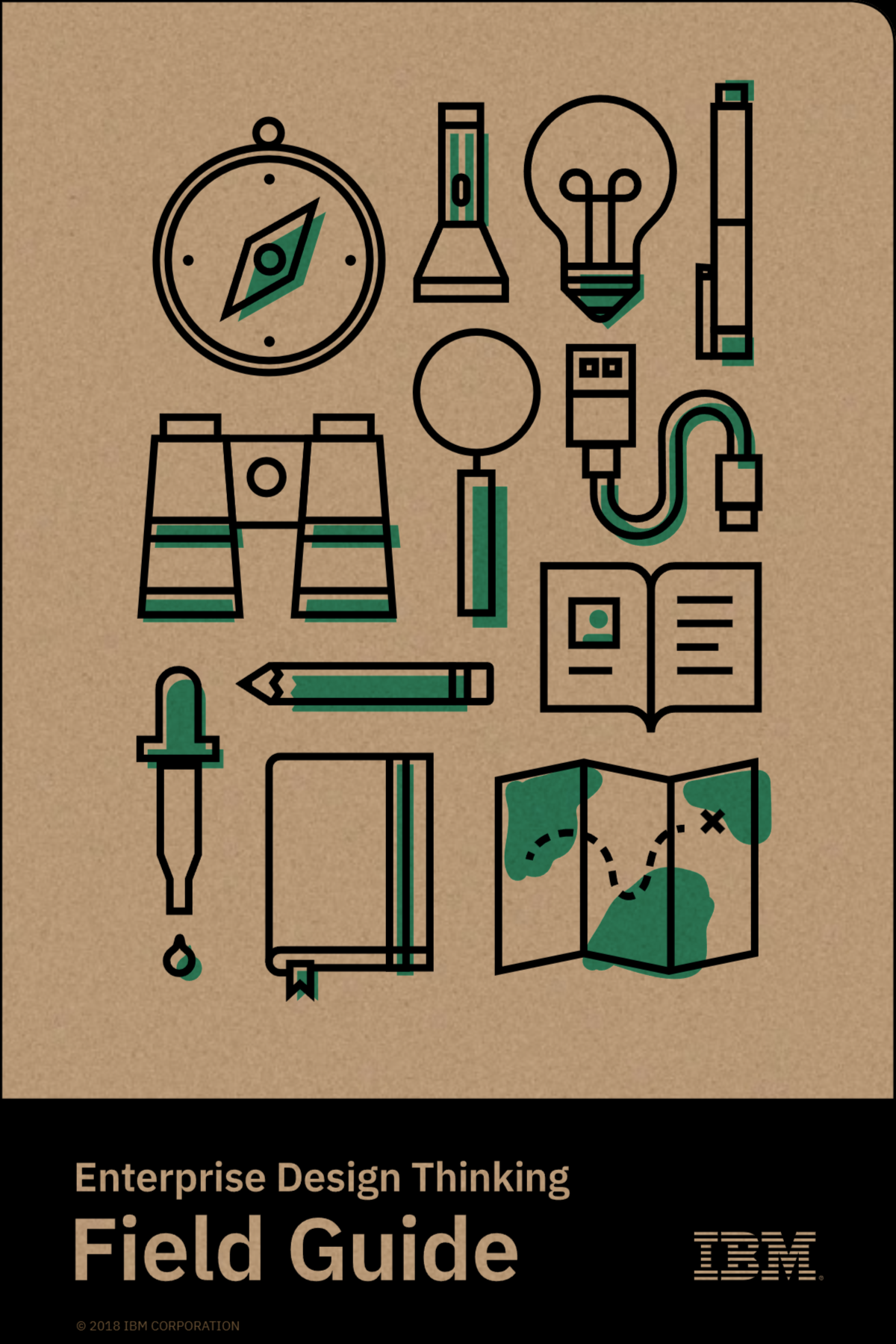IBM’s Design Thinking method is known as Enterprise Design Thinking. It is a framework for solving complex problems at scale while keeping users at the center. Developed to address challenges in modern enterprises, the method emphasizes collaboration, rapid iteration, and measurable outcomes.
The IBM’s “Enterprise Design Thinking Field Guide” is updated frequently. Download the latest version at: ibm.biz/fieldguide-public

Principles of Enterprise Design Thinking #
These principles help teams navigate ambiguity and align their efforts toward impactful results:
- Diverse Empowered Teams: Diverse perspectives generate innovative ideas. Teams must have the authority and expertise to drive these ideas to outcomes.
- Focus on User Outcomes: Success is measured by how well solutions meet user needs, not by the number of features delivered.
- Restless Reinvention: Treat every solution as a prototype. This mindset encourages constant improvement, even for live products.
The Core Behavioral Model: The Loop #
At the heart of IBM’s methodology is “The Loop,” a cycle of Observe, Reflect, and Make:
- Observe: Immerse in user environments to understand their challenges and opportunities.
- Reflect: Align as a team by analyzing insights, forming a shared point of view, and planning next steps.
- Make: Develop tangible prototypes to test concepts and iteratively refine ideas based on feedback.
The Loop ensures continuous engagement with users, enabling iterative learning and solution refinement.
Key Practices and Tools #
IBM’s framework includes tools and practices designed to foster collaboration, creativity, and alignment:
- Hills: Clearly defined project goals focused on user outcomes. Each Hill identifies a specific user, action, and measurable impact, aligning teams on priorities.
- Playbacks: Regular feedback sessions to share progress and gather input from stakeholders and users. Playbacks ensure transparency and course correction.
- Sponsor Users: Real users engaged throughout the process to bridge gaps between assumptions and actual needs. Their input informs decisions and validates concepts.
Activities to Foster Collaboration #
IBM provides structured activities to help teams understand users, generate ideas, and test solutions:
- Empathy Maps: A tool to visualize what users say, do, think, and feel, fostering a deep understanding of their perspectives.
- Scenario Mapping: Documents current and envisioned user workflows to identify pain points and opportunities.
- Prioritization Grids: Helps evaluate ideas based on user importance and feasibility, ensuring focus on high-impact solutions.
- Storyboarding: Visual storytelling to communicate and iterate on user experiences effectively.
These activities encourage inclusivity, creativity, and alignment, helping teams move beyond feature-centric delivery.
Integrating Agile and Design Thinking #
IBM’s approach aligns closely with Agile principles, emphasizing iteration, collaboration, and adaptability. Enterprise Design Thinking identifies the right problems to solve, while Agile focuses on how to solve them. Together, they enable continuous improvement through experience mapping and feedback loops.
Benefits of Enterprise Design Thinking #
IBM’s methodology delivers several key advantages:
- Improved Collaboration: Cross-disciplinary teams work together from the start, leveraging diverse expertise.
- Faster Iteration: Prototypes and user feedback drive rapid learning and solution refinement.
- User-Centered Outcomes: Focus on user needs ensures solutions create real value.
- Scalability: Designed for complex teams and problems, the method scales effectively across organizations.
IBM Toolkit to Hone Your Design Thinking Skills #
IBM provides Enterprise Design Thinking Toolkit and Practitioner Course for free.
Toolkit includes presentations with activities and templates you can use to practice Enterprise Design Thinking methods:
| Activity/Artifact | Purpose | Tag(s) | |
|---|---|---|---|
| As-is Scenario Map Download activity |  | Build understanding of users’ current experiences. | Reflect, Synthesize research |
| Assumptions and Questions Download activity |  | Identify assumptions and key questions for clarity and direction. | Reflect, Plan your work |
| Big Idea Vignettes Download activity |  | Brainstorm and rapidly generate solutions for user needs. | Make, Generate new ideas |
| Empathy Map Download activity |  | Foster user empathy through discussions informed by team observations. | Reflect, Synthesize research |
| Experience-based Roadmap Download activity |  | Focus on critical short-term outcomes for users. | Make, Plan your work |
| Feedback Grid Download activity |  | Gather and organize feedback from users, team members, or stakeholders. | Reflect, Test your ideas |
| Hills Download activity |  | Define clear intent in terms of user outcomes and market value. | Reflect, Plan your work |
| Hopes and Fears Download activity |  | Align team members by discussing their hopes and fears for a project. | Reflect, Align your team |
| Needs Statements Download activity |  | Outline what users need to achieve their goals. | Reflect, Synthesize research |
| Playbacks Download activity |  | Share work and exchange feedback to align stakeholders. | Reflect, Align your team |
| Prioritization Grid Download activity |  | Focus decisions on the intersection of importance and feasibility. | Reflect, Plan your work |
| Stakeholder Map Download activity |  | Identify stakeholders, their expectations, and interrelationships. | Reflect, Synthesize research |
| Storyboards Download activity |  | Communicate ideas through visual narratives to integrate them into users’ lives. | Make, Generate new ideas |
| To-be Scenario Map Download activity |  | Draft a vision for users’ future experiences to address current needs. | Make, Generate new ideas |
Enterprise Design Thinking empowers organizations to innovate at scale while staying user-focused. By fostering collaboration, encouraging iteration, and prioritizing outcomes, IBM’s framework helps teams navigate complexity and deliver impactful solutions.

Leave a Reply